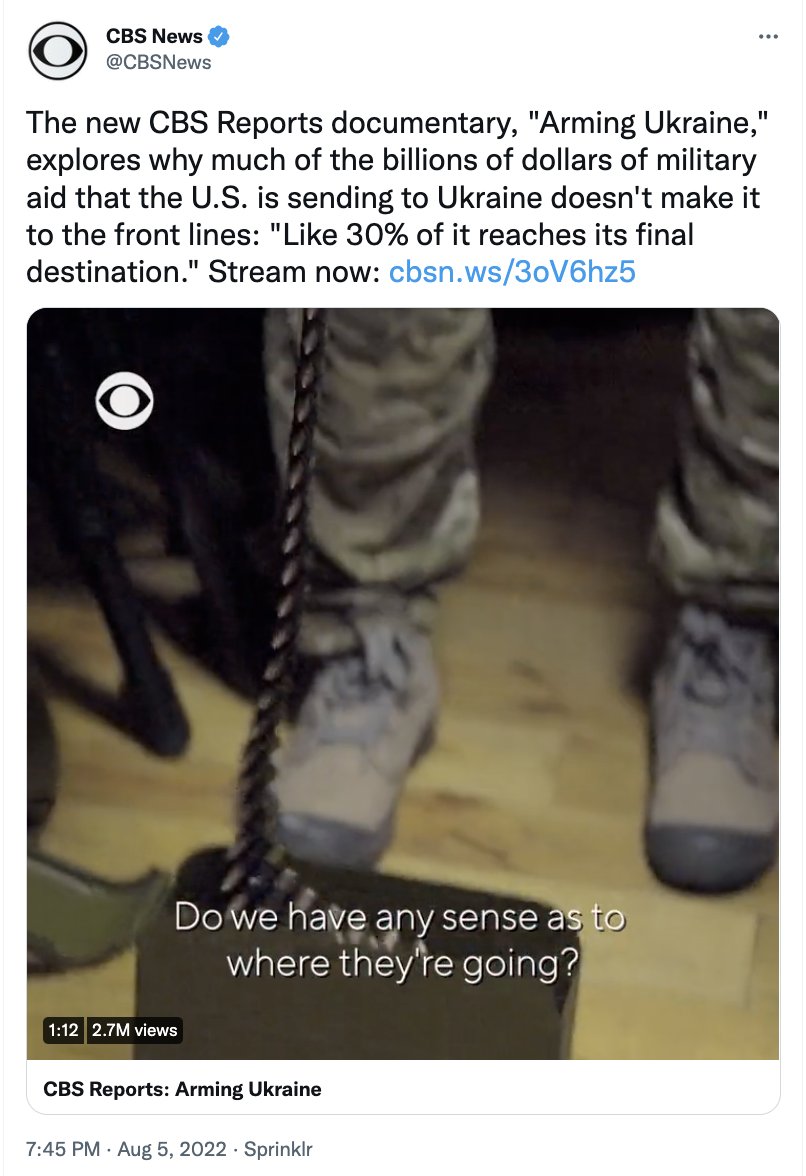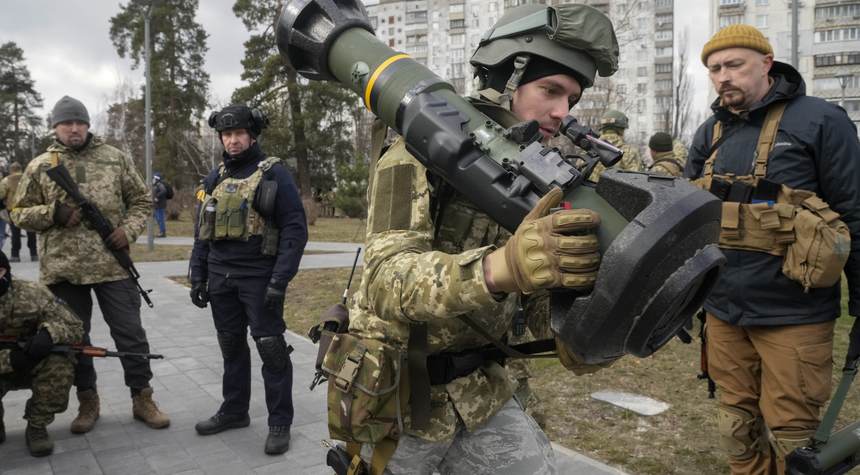Tuesday, unnamed sources within the race-and-genital-obsessed Biden Defense Department told the Washington Post that the number of US military weapons inspectors assigned to monitor weapons shipments to Ukraine had been increased.
U.S. officials, who spoke on the condition of anonymity to provide details that have not been made public previously, said they are racing to deploy new means for tracking weapons seen as having a heightened risk of diversion, including Stinger surface-to-air missiles and Javelin antitank missiles, amid what they describe as Ukraine’s “super hot conflict.”
They hope to achieve a “reasonable” level of compliance with U.S. oversight rules for those high-risk items, but also acknowledge that they are unlikely to achieve 100 percent of normal checks and inventories as the country’s escalating war with Russia strains systems for ensuring weapons are not stolen or misused.
Since late February’s invasion, which prompted the closing of the U.S. Embassy in Kyiv for several months, U.S. officials have been able to conduct just two in-person inspections of items requiring enhanced oversight at weapons depots where U.S. arms had been brought in from Poland.
This is a good thing. Ukraine has received substantial military hardware from the United States, and we should want to know where it is going. This list is from the Congressional Research Service Report, U.S. Security Assistance to Ukraine, dated October 21, 2022.
Accountability of the particularly lethal materiel is critical for Ukraine’s successful defense of its sovereignty. Donor nations must have confidence that the Ukraine military is making a good-faith effort to control weapons, weapons systems, and ammunition and prevent them from being siphoned off by criminal elements. The allegation that weapons are being diverted has surfaced repeatedly from Russia-friendly and Russian-controlled sources and US media in search of a hot story. In August, for instance, CBS aired a documentary called “Arming Ukraine.”

This is an excerpt from my post on this discredited journalistic effort titled CBS Pulls Fatally Flawed Documentary ‘Arming Ukraine’ From Circulation.
Unlike many commenting on the documentary, I reviewed and took notes on it as I’d planned to write on it this week. I was first aware that the piece had been pulled when the link I’d embedded to the documentary in this story returned a 404 yesterday.
The center of the documentary is Jonas Ohman, who runs a non-governmental organization (NGO) called Blue Yellow. It has been collecting/purchasing, and distributing non-lethal aid to a “patchwork of improvised military units,” his words, not mine, since 2014. Ohman says his organization only moves non-lethal aid, and he doesn’t supply regular Ukrainian forces.
The documentary was filmed in late-April-to-mid-May. The leaves on trees are just forming, and no crops are growing in the fields. So it was filmed before the first large tranches of US military aid started arriving.
At no point in the video does anyone claim that only 30 percent of Western weapons make it to military units. The 30 percent quote doesn’t appear in the CBS article on the documentary, and RT only mentions it when it quotes the CBS promo. The 30 percent number refers to a statement made by Ohman on his estimate of the percentage of non-lethal aid provided by his NGO that reaches the front lines. The still image below shows when this happens. Strangely, no follow-up question asks why this is so and where the other 70 percent ends up, though, were I forced to guess, I’d say that part of the problem is that Blue Yellow doesn’t deliver supplies to units; they deliver them to civilian cut-outs who make the final delivery (this was at 6:50 into the documentary).
Blue Yellow has responded to the CBS documentary.
At no point in the documentary is anyone involved in weapons transfers interviewed. However, they do manage to interview Donatella Rovera, Senior Crisis Adviser for Amnesty International, of all things.
In short, the documentary was about how one specific NGO obtains and distributes non-lethal military gear (helmets, body armor, cars, drones, optics) to provisional Ukrainian military units. It is not about weapons, ammunition, or even the Ukrainian military. Why it was promoted in the way it was is a question for CBS to answer.
The episode does raise a fair question. How well do donor countries track the military aid they provide to Ukraine? As the Amnesty International person accurately points out, the weapon producer has responsibility for their weapons. That is how Germany has been able to restrict users of the Leopard 2 main battle tank from transferring them to Ukraine. That said, a pretty intense war is being waged, and large amounts of weaponry are captured, lost, and abandoned daily. Moreover, these weapons are at least as much Russia’s property as Ukraine’s.
In July, Ukraine invited donor nations to set up processes to ensure their weaponry was making its way to the Ukrainian Army and created a commission to monitor weapons transfers. The US has a team headed by Brigadier General Garrick Harmon commanding the US Army Security Assistance Command in Ukraine. Weapons and aid are being managed according to NATO’s LOGFAS system.
Europol has investigated the black marketing of arms from Ukraine and said they have found signs of weapons smuggling from Ukraine, and the Ukrainian government is fully cooperating. RT (lolgf) has carried out an “investigation” of arms on the “dark web.” No weapons changed hands, and no evidence presented that they had been diverted from supply channels and not abandoned or captured.
Pro-Putin commenters like Michael Tracey lost their crap when the documentary was pulled, mostly because he was so far out over his skis pushing the Kremlin line that the only thing left for him to do was to make a face-plant.
In June, a story appeared concerning a sale of a Javelin anti-tank missile for $30,000 on the “dark web.” It is one of those stories that has no corroboration other than the website. Naturally, whether you believed it tracked pretty well with your affection for Russia.
This week, another story on weapons from Ukraine finding their way into criminal hands boiled up from Finland. On Monday, the Finnish outlet YLE quoted a Detective Superintendent Christer Ahlgren of Finland’s equivalent of the FBI (hopefully, only in function and not competence), the National Bureau of Investigation, as saying some small arms sent to Ukraine have ended up in the hands of Finnish motorcycle gangs (apparently they are a thing, see Outlaw Bikers in Finland and Nordic Biker War).
The Finnish NBI issued a statement that made it clear that there are no confirmed cases of weapons linked to Ukraine being recovered in Finland.
The Finnish Broadcasting Company YLE reported on Sunday 30 October 2022 on weapons being trafficked from Ukraine to Finland. The story was based on YLE’s interview of Detective Superintendent Christer Ahlgren of the NBI. Based on the interview, YLE published a story in Finnish and a shorter version in English.
The NBI considers that the perception, based on the interview, that weapons donated to Ukraine are being trafficked to members of organised crime in Finland, is not accurate. The police have no evidence showing that donated weapons would have been smuggled from Ukraine to Finland.
– We don’t know that weapons supplied to Ukraine would have ended up in the hands of criminals in Finland, says Markus Välimäki, Deputy Director of the NBI.
The police seize numerous unlicensed weapons from members of organised crime every year and are aware that individual operators are interested in weapons used in war zones. The police have indications that, in the long run, members of organised crime may try to acquire weapons from Ukraine, too.
– Based on the interview of our expert, people may have got the impression that there have already been weapons trafficked to Finland. However, we have no evidence of such phenomenon. Our purpose was to show that there is a possibility that criminals operating in Finland are trying to obtain weapons from conflict zones, says Välimäki.
Of course, a fact that wasn’t mentioned in this story was through which countries would small arms from Ukraine have to pass to get to Finland.
The bottom line is that under international law, it is our responsibility to monitor the weapons that we ship to Ukraine to guarantee that bona fide representatives of the Ukraine Armed Forces accept the shipments, we have to have confidence that the weapons are under an acceptable level of control by the Ukraine Armed Forces, and we have to ensure that these weapons are not passed to third parties in violation of the End User Certificate for the weapons. And even with all the safeguards possible, there will be leakage of small arms. What everyone hopes doesn’t happen is that Stingers, Ghost and Switchblade drones, and Javelins also don’t get diverted.
As of June 30, the agency charged with this task, the Defense Security Cooperation Agency (DSCA), had just ten soldiers to do the task.
The increase in inspectors is part of a detailed, public plan released by the State Department titled U.S. Plan to Counter Illicit Diversion of Certain Advanced Conventional Weapons in Eastern Europe.
Almost as soon as this increase in DSCA inspectors was announced, the usual suspects started chanting “boots on the ground” and claiming that the troops sent to Ukraine were advisors or trainers or something that would hurt the beloved Putin.
No numbers have been made public of how many DSCA personnel will be assigned the task. However, the lion’s share will work at the logistics facilities in western Ukraine, where US shipments terminate.
If you want to claim this is a cover for inserting Delta into Ukraine, you’re free to do so. However, there are easier ways of doing that which don’t involve compromising the DSCA mission throughout the world or a background briefing to the Washington Post.



